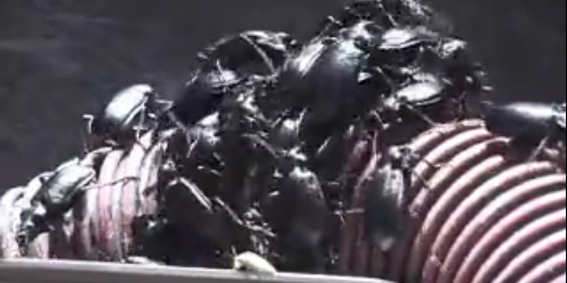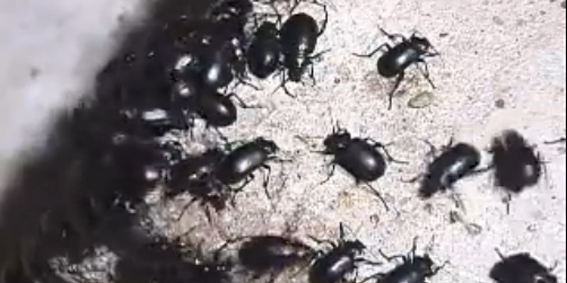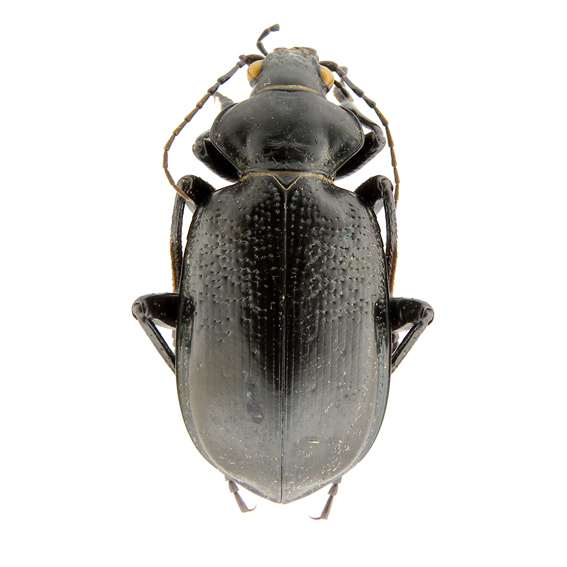Calosoma (Camedula) marginale Casey, 1897
Calosoma lugubre LeConte, 1853: 400 (nec Motschoulsky, 1844) type material: not stated, description compatible with one specimen ♂ (from New Braunfels, Texas); lectotype ♂ in Museum of Comparative Zoology, Harvard University, Cambridge, MA (https://mczbase.mcz.harvard.edu/) (preoccupied by Calosoma lugubre Motschulsky, 1844 = Calosoma denticolle Gebler, 1833)
Calosoma marginalis Casey, 1897: 340 (type locality: Arizona); holotype ♂ by monotypy in National Museum of Natural History, Washington (https://collections.nmnh.si.edu/)
Calosoma lecontei Csiki, 1927: 21 (unnecessary nomen novum pro lugubre LeConte)
Calosoma (Camegonia) lecontei Breuning, 1928: 97
Callitropa (Camegonia) lugubris Lapouge, 1932: 387
Camedula (Camegonia) lecontei Jeannel, 1940: 207
Calosoma (Camegonia) marginalis Gidaspow, 1959: 281
Calosoma (Carabosoma) marginale Erwin, 2007: 98
Length 26-32 mm. C. marginale, C. parvicolle and C. prominens were included toghether in the ancient Camegonia subgenus (sensu Jeannel, 1940) characterized by the lack of setae on the metatrochanters. All the species have an aspect glossy and a black colour, sometimes with very faint metallic reflections.
C. marginale is easily distinguished because the sides of the pronotum are, at most, very slightly angular; the elytra are with very faint striae and in their basal part we find sparse large punctures connected by deep creases.
Gidaspov (1959: 254) has restored the original name of Casey, because she considered that there were no need to use the name lecontei introduced by Csiki in 1927.
C. marginale is mainly found in the south central semiarid prairies of the United States, East of the Rocky Mountains (Colorado, New Mexico, Kansas, Oklahoma, Texas), as well as further south in the neighboring semiarid plains of Mexico (Nuevo Leon, Tamaulipas) Towards the west it is also found in Utah and Arizona in the United States and in Mexico in Baja California, Sonora, Chihuahua.
It is a vagile species, a good flyer, adaptable at the anthropic environment when the natural habitat is destroyed, and it sometimes develops into large assemblages of individuals. There are report of its presence even very far from the area of greatest diffusion, but the reports do not necessarily indicate a stable presence. Towards the East single specimens of C. marginale can occasionally reach Kentucky and Florida and northwards South Dakota and Canada, in this last case almost certainly as stray (Lindroth, zed1961: 49). More towards South Gidaspow reported a catch in the state of Morelos in Mexico (1959: 255) and in Costa Rica (1963: 282) without further precision. Erwin (1991: 18), although not having seen specimens from Costa Rica, does not excluded the possibility that C. marginale can be found there.
Some of these presences of isolated individuals can be attributed to passive transport facilitated by modern traffic intensification. Cases of this type have occurred in Hawaii, where the species was imported as a potential biological control agent, but acclimation failed, while it has happened that a specimen occasionally reached the archipelago via shipments originating from the United States or Mexico (Liebherr et al., 2023).
Material examined:
Canada. Québec: Lake Duparquel (Lindroth, 1961: 49).
Mexico. Baja California (Gidaspow, 1959: 256): Ensenada (www.inaturalist.org), Catavina (http://bajanature.com/); Baja California Sur: Sierra de la Giganta, La Paz (http://bajanature.com/); Chihuahua: Samalayuca (Gidaspow, 1959: 254); Coahuila: Cuatro Cienegas National Reserve (UASM); Jalisco: Yahualica de González Gallo (www.inaturalist.org); Morelos: Cuernavaca (Gidaspow, 1959: 254); Nuevo Laredo: Gral Escobedo (www.inaturalist.org); Nuevo Leon: Allende, Apodaca, Monterrey, Santiago (Gidaspow, 1959: 254), Compostela Juárez (www.inaturalist.org); Sonora: Imuris (http://madrean.org/), Pitiquito, Hermosillo (www.inaturalist.org); Tamaulipas: Nuevo Laredo (Bates, 1991: 224), Ciudad Mante (UASM), El Mante (Gidaspow, 1959: 254).
United States. Arizona: Tucson, Green Valley (www.inaturalist.org); Arkansas: Washington County (SB), Arkansas County (Bousquet, 2012: 233); California (Erwin, 2007: 98); Colorado (Gidaspow, 1959: 254): Trinidad (www.inaturalist.org/); Florida: Miami-Dade county (www.inaturalist.org); Iowa (Bousquet, 2012: 233); Kansas: Sedgwick County (Breuning, 1928a: 99), Elkhart (www.inaturalist.org/), Morton County (http://bugguide.net/), Riley County (Jeannel,1940: 96), Atkinson (SB), Kiowa (www.gbif.org), Stafford County (www.inaturalist.org); Kentucky: Muhlenberg county (www.inaturalist.org/obs/12206522); Missouri: Vernon county (www.gbif.org); Nebraska: (SB), Lancaster County (http://bugguide.net/); Nevada: Vernon county (UASM), Carson City (www.inaturalist.org/); New Mexico: Roswell, Cloudcroft, Albuquerque (Breuning, 1928a: 99), Portales, Otero County, Alamogordo (www.inaturalist.org/), Chaves Co (www.gbif.org); Oklahoma: Ardmore (EM), Cithrie (Breuning, 1928a: 99), Fort Supply, Woodward County, Stillwater, Oklahoma County (www.inaturalist.org/), Texas County (http://bugguide.net/), Seminole County (http://bugguide.net/); Texas: Brazos County (SB), Brewster County (http://bugguide.net/), Comal County (http://bugguide.net/), Willacy County (EM, SB), Victoria County (EM), San Antonio (EM), Raymondville (EM), Comal County: New Braunfels (Breuning, 1928a: 99), Seymour (WWW.arkphoto.com), Hidalgo County (http://bugguide.net/), Cottle County, Travis County, Denton County, Wise County, Williamson County (www.inaturalist.org), Frio county, Dallas (UASM), Cameron County, Zapata, Kimble County (www.inaturalist.org); Utah: Spanish Valley, San Juan County (www.inaturalist.org).
Notes: Winged, attracted to light at night, sometime swarming in very large number. Lives in desert or semidesertic areas as well on pastures and tilled fields, from lowlands up to an altitude of 1800m. In daytime, the adults take refuge in more shady or humid areas, under bushes. According to ancient but extensive laboratory studies (Burgess & Collins, 1917: 79), adults and larvae can destroy large number of caterpillars and feed on and near the ground. Active individuals have been noted from May to November, and in some areas adults can be found overwintering in the soil. (Larochelle & Larivière, 2003: 178).
 light at a petrol station, in Texas Seymour may 23 2001 WWW.arkphoto.com |
 |
 Casey, 1897 United States, Texas: Willacy county, Lyford, 4.VIII.65, DG Ford |
 Casey, 1897 United States, Texas: Willacy county, Lyford, 4.VIII.65, DG Ford |